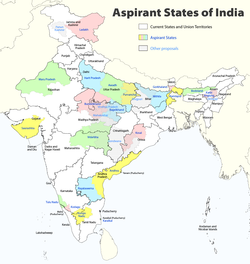Bodoland Territorial Region
Bodoland, (also Boroland), officially the Bodoland Territorial Region, is an autonomous region in India. It made up of four districts on the north bank of the Brahmaputra river, by the foothills of Bhutan and Arunachal Pradesh. It is administered by an elected body known as the Bodoland Territorial Council which came into existence under the terms of a peace agreement signed in February 2003 and its autonomy was further extended by an agreement signed in January 2020. The region covers an area of over eight thousand square kilometres and is predominantly inhabited by the Bodo people and other indigenous communities of Assam.[3][4]
Bodoland | |
|---|---|
| Bodoland Territorial Region[1] | |
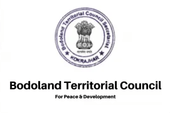 Seal | |
| Motto(s): | |
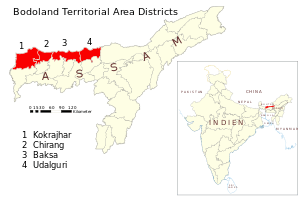 Bodoland within Assam | |
| Country | |
| State | Assam |
| Established | 9 February 2003 |
| Headquarters | Kokrajhar |
| Districts | 4 |
| Government | |
| • Body | Bodoland Territorial Council |
| • Chief Executive Member | Vacant (Governor's rule)[2] |
| • Speaker | Vacant (Governor's rule)[2] |
| Area | |
| • Total | 8,821 km2 (3,406 sq mi) |
| Population (2011) | |
| • Total | 3,155,359 |
| • Density | 360/km2 (930/sq mi) |
| Demonym(s) | Bodo |
| Languages | |
| • Official | Bodo, Assamese, English, Hindi |
| Time zone | UTC+5:30 (IST) |
| Website | www.bodoland.in |
Etymology of Bodoland
The Plains Tribes Council of Assam had demanded, since its inception in 1967, for a separate union territory for the Boro and other plain tribes to be called Udayachal.[5] With the failure of PTCA, the All Bodo Students' Union launched the Bodo Movement in 1987 with the demand for a separate state to be called Bodoland,[6] ending with the Bodo Accord of 1993 with the formation of Bodoland Autonomous Council.[7] Bodoland is named after Bodo, an alternative spelling of the Boro people who live primarily in the Dooars regions of Goalpara and Kamrup districts.
History
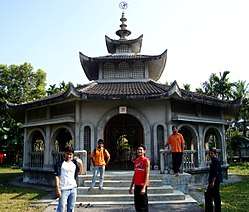
Historically Bodoland Territorial Region was inhabited by the Boros or Bodos or Kacharis and Mechs. During the reign of Kamata king Nara Narayan, the country at foot of Bhutan Hills i.e. Eastern and Western Duars were given to Bodo tribe due to superstitious belief and Bhutan aggression.[8] Those regions were known as Kachari Duar and Mech Duar. The British gained control of the region through the Treaty of Yandabo upon winning the First Anglo-Burmese War in 1826. The war was primarily for the control of Northeast India between the British and Burmese empires. It was than known as the Kachari Dwars or Kachari plains or Kachari country by the British during the British Raj. The Bodo people in the Brahmaputra Valley have survived in the midst of Khilji, Mughal, Aryan and Shan invaders and settlers. Mech-Koch descent Kamata kings ruled various parts of Lower Assam and North Bengal. Open caste Koch have become a semi-Hinduised aboriginal caste, due to inter-marriage who now speak Kamtapuri or Assamese. Surviving remnants of the royal family of Koch empire proved aboriginal members of the Koch caste spoke Bodo language. After Bodoland separate state movement, these tribal regions are named Bodoland.
Demand for statehood
Along with the other parts of Northeast India, regional aspiration in the region reached a turning point in the 1980s. The isolation of the region, its complex social character, and its backwardness compared to other parts of the country have all resulted in the complicated set of demands ranging from demand for autonomy and opposition to 'outsiders' to movements for secession.
The region is also the gateway to the North Eastern Region of India, where one of the main students organization, All Bodo Students Union (ABSU), allied with National Democratic Front of Boroland - Progressive (NDFB-P), National Democratic Front of Boroland - D.R. Nabla faction, People's Joint Action Committee for Boroland Movement (PJACBM) which is an amalgamation of over three dozen Bodo organisations[9] and its supporters are demanding from the Government of India that a separate state (within the Indian Union) be created comprising the seven districts of Kokrajhar, Chirang, Baksa, Udalguri, Sonitpur, Lakhimpur and Dhemaji of Assam which have a significant Bodo population.[10][11] On the other hand, it is also claimed as a sovereign state (Complete independence) by the separatist insurgent group NDFB.[12]
1993 and 2003 peace agreements
Following an agreement in 1993, Bodoland became an autonomous administrative unit constituted under the Sixth Schedule of the Constitution of India covering an area of 8,795 km2 administered by the Bodoland Autonomous Council.
Following a further peace agreement, the Bodoland Territorial Council was formed in 2003, with a mission to accomplish development in the area of economic, education, preservation of land right, linguistic aspiration, socio-culture and ethnic identity of Bodos and above all to speed up the infrastructure development of communities in the Bodoland area. The actual functioning of the council was started on 7 December 2003 by constituting the 12 members of the Council provisionally.
After the Council Election on 13 May 2005 and subsequent bye-election in November 2005, the 40-member Legislative Council has been formed to look after the development works in the Bodoland Territorial Area Districts. The remaining six members are nominated by the Governor of Assam from the unrepresented Communities. Thus there are altogether 46 members of the Council, representing all communities of BTC Area known as Member of Council Legislative Assembly (MCLA).
2020 peace agreement and the formation of the Bodoland Territorial Region
A new peace agreement was signed on 27 January 2020 between the Government of India and the Government of Assam on one side and the National Democratic Front of Bodoland, (NDFB) the All Bodo Students’ Union and United Bodo People's Organisation on the other.[13] Under the terms of this agreement, a Bodoland Territorial Region was formed with enhanced executive and legislative powers. The Bodoland Territorial Council will have competency over almost all areas defined by the Sixth Schedule of the Constitution of India and its membership will be increased to 60.[14] New districts will be created and the boundary of the region will be adjusted to include Bodo inhabited areas from neighbouring districts and exclude non-Bodo inhabited villages currently under the jurisdiction of the BTC.[15] Bodoland will also have the right to be represented at national level sports and cultural events such as the National Games of India and the Khelo India Youth Games.[16]. The agreement also makes the Bodo language with Devnagri script an associate official language of Assam.
Government and Politics
Bodoland Territorial Council
The region is administered by an elected body known as the Bodoland Territorial Council (BTC) which was established according to the Memorandum of Settlement of 10 February 2003. BTC came into existence immediately after the surrender of Bodo Liberation Tigers Force (BLTF). The BLTF laid down their weapons on 6 December 2003 under the leadership of Hagrama Mohilary and Hagrama was sworn in as the Chief Executive Member (CEM) on 7 December 2003.
The BTC has 46 members (30 seats reserved for scheduled Tribes, 5 seats for non-scheduled tribes and 5 open seats) and 6 seats of which are nominated by Governor of Assam from unrepresented communities. The council appoints a cabinet of 14 executive members each looking after a specific area of control.
The most recent session of the council ended on 27 April 2020 and as a result of the postponement of elections scheduled for 4 April 2020 a result of the global Covid-19 pandemic, Bodoland was placed under Governor's rule until a new council can be elected.[2][17]
Districts
The Bodoland region is made up of four districts which are further subdivided into 10 Civil Subdivisions and 40 Development Blocks.[18]
The area and population under the four districts has been estimated as follows:
| No | Name | Area (km2) | Population (census 2011) |
|---|---|---|---|
| 1 | Kokrajhar | 3,169.20 | 887,142 |
| 2 | Chirang | 1,069.96 | 482,162 |
| 3 | Baksa | 3,056.89 | 950,075 |
| 4 | Udalguri | 1,673.93 | 831,668 |
| Total | 8,969.98 | 3,151,047 |
Geography
The geographical boundary of the BTR lies between 26° 7'12'' N to 26° 47' 50'' N Latitude and 89° 47' 40'' E to 92° 18' 30'' E Longitude and is in the North Western part of Assam. Kokrajhar town the Administrative Head Quarter lies roughly between 26° 25' N latitude and 90° 16' 38'' E Longitude.
Its strategic location is blessed with beautiful forests of flora and founa.[18]
Economy
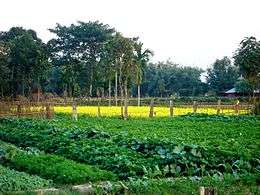
The economy is largely agricultural based and is lagging behind in urbanization and development. The region is industrially backward with most of its population depending on agriculture for livelihood. Most of the industries like oil, gas and major industries of the state are located in upper Assam.
Urbanisation
The region is one of the most underdeveloped and backward regions of India of which only 3 percent of the population live in urban areas.
Tourism
Tourism in the region is regulated by the department of Bodoland Tourism. Manas National Park is the major tourist attraction of the region. It also has many wildlife sanctuaries, reserve forests, site seeings, picnic spots, and events.[19]
Manas National Park
Manas, the nature's abode is at the foothills of Bhutan with its unique biodiversity and landscape. The blending of the dense jungle and grassland at the confluence of Indian, Ethiopian and Indo Chinese realms enhances it as one of the richest region of wild animals. The Park harbours 60 species of mammals of which 23 has been listed in Schedule 1 under the Indian Wildlife Protection Act 1972. The Park also has a recorded count of 36 species of reptiles and 476 species of birds. The Park is home for Elephant, Rhino, Tiger, Gaur, Wild Buffalo, Deer, Wild Hogs, and many other Reptiles, Birds and Insects including some highly endangered species like Pygmy Hog, Golden Langur & Bengal Florican. It is not only a significant National Park of India but also an important migratory corridor for the elephant population of the entire Indo-Bhutan region. Manas is also included in the much ambitious plan nomenclature as Indian Rhino Vision -2020 (IRV-2020) since 2006, with the support of Govt. of Assam in collaboration with Wildlife Trust of India, (WTI), Bodoland Territorial Council, WWF-India, International Rhino Foundation, and US Fish and Wildlife Service.
Trekking of Baukungri Hill
Baukungri hill trekking is an exciting and adventurous event that is organised every year on the first day of the year according to Bodo Calendar which falls in mid-April. People from neighbouring states along with the host state arrives every year for a week. International tourists from neighbouring Countries and Westerns Countries are also among those who wait for this exciting event. Cultural and traditional fusion of various ethnic groups can be seen during this event. Tourists can have the taste of this rich cultural event with wide range of mouth-watering cuisines of the native people.
Gethsemane Man-made Forest[20]
Situated in Udalguri's Bhairabkunda, it is a forest-grown entirely by local JFMC of 35 members with the help of Forest department of Assam. Spread across more than 6 km2, the forest contains more than 14 lakh plus trees of over 35 varieties. A number of animals, birds and reptiles can also be spotted in the area. Visitors can trek through the trail in the forest and stay the night in their Guest house.
Infrastructure
Transportation
The Bodoland Transport Service (BTS) manages bus services in the region. Bodoland Transport Service buses have a direct bus service to the capital of assam Guwahati and capital of Meghalaya shillong[21] The service initially ran 4 buses across the four districts but currently operates 16 buses that generates INR 18,00,000 annually according to a recent report.
Energy
Electricity
State Power Sector Reform Programme under the provision of electricity act 2019 resulted in the unbundling of Bodoland territory Electricity Board
The Bodoland Power Generation Corporation Limited is mainly responsible for maximum energy generation to meet up the energy demand in the territory of Bodoland,[22] while the latter is responsible to efficiently transport electrical power from electrical power bulk heads to the distribution company networks in the territory of Bodoland.[23]
The primary purpose of the Bodoland Power Distribution Company Limited is to undertake distribution, trading and supply of electricity in the territory of Bodoland or outside of it.[24]
Demographics
Population
Bodos are the majority community in the region numbering around 1 million (30%) followed by Bengali Muslims, who form the largest minority group.[25] The population of BTC area as per 2001 Census report is 2,920,000 out which the ST population is around 27% of which only 3% of the total population live in urban areas. The average density of the population in BTC is 326 per Sq.K.m. compared to 340 per Sq.K.m. of Assam. Amongst the ST/SC population Bodos, Rabhas, Keots (Kaibartas) and less quantity of Garos are inhabiting in this area out which Bodos will be 90% or approximately 1,400,000.[25] The other communities like Rajbongshi, Sarania are inhabiting in large part of BTC. Tea and Ex Tea-tribes including Santhal, Oraon etc. are also available. Moreover, other general communities like Bengali, Gorkha and few numbers of Hindi speaking people are also found in the Council area.[26]
Education
Literacy rate
Bodoland has a literacy rate (7 years and above) of 61.3%.[27]
Culture

The Bodos have a distinct culture from the rest of the world, ranging from dance and music to festivals and attires. It also contributed significantly to the development of the Assamese culture and Assamese language.
Sports
Football is the most popular sport in the region. The region has many Football clubs of which Baarhoongkha AC, Udalguri FC and Global FC is the most widely known as they participate in Assam State Premier League, the premier football league of the state. Bodoland Martyrs Gold Cup is organised every year in memory of Bodoland martyrs, who sacrificed their lives for the cause of Bodoland movement.[28] The region has also produced many national level athletes. Other sports followed in the region are Badminton, Basketball, Volleyball, Cricket, Taekwondo, Kabaddi, Chess, Archery, and other indigenous sports.[29]
See also
- Bodo people
- Bodo culture
- Bodo language
- Bodo Sahitya Sabha
- 2012 Assam violence
References
- https://www.livemint.com/opinion/columns/optimal-delivery-or-mere-optics-in-bodo-peace-deal-11580407583890.html
- https://www.indiatoday.in/india/story/assam-governor-takes-over-bodoland-territorial-council-in-absence-of-term-end-polls-1671802-2020-04-27
- "Bodoland Territorial Council (BTC) Accord". cdpsindia.org. Archived from the original on 19 April 2012. Retrieved 15 December 2011.
- https://ucdpged.uu.se/peaceagreements/fulltext/India%2019930220.pdf
- "(T)he Bodo leadership in 1967 formed a political party called the Plains Tribals Council of Assam (PTCA). Since its formation, the PTCA has categorically demanded a union territory for the Bodosand other Plains tribals of the region called Udayachal." (George 1994:879)
- "ABSU took over the leadership of the Bodos; it launched a movement for greater autonomy on March 2, 1987, with the demand for creation of a full fledged state of Bodoland outside of Assam." (George 1994:880)
- "These efforts ultimately resulted in the Bodo Accord, signed at Guwahati on February 20, formally ending the six-year Bodoland agitation...The Bodo Accord provides for a Bodoland Autonomous Council (BAC)..." (George 1994:887)
- (Allen 1905:66)
- "Bodo groups impose 12-hour 'bandh' in Assam over statehood demand". www.hindustantimes.com. 11 September 2017.
- "A demand for Bodoland, with blood". www.telegraphindia.com.
- Bodoland Teer
- T8N (14 September 2017). "NDFB(S) eyes Bodoland sovereignty". Archived from the original on 16 March 2018. Retrieved 27 September 2017.
- https://www.indiatoday.in/india/story/amit-shah-historic-bodo-peace-accord-sign-assam-1640584-2020-01-27
- https://timesofindia.indiatimes.com/blogs/toi-edit-page/how-the-bodo-accord-was-accomplished-establishing-a-wider-template-for-peace-in-the-northeast/
- https://www.news18.com/news/india/kmss-leader-akhil-gogois-judicial-custody-extended-2496251.html
- https://indusscrolls.com/what-is-bodo-peace-accord-read-the-full-text-of-draft-bodo-treaty/
- https://www.time8.in/governors-rule-imposed-in-assams-btc/
- "About Bodoland". www.bodoland.in. 2 December 2018.
- "Bodoland Tourism". www.bodolandtourism.org. Retrieved 26 March 2017.
- "Afforestation changes life and landscape: How a district in Assam lost a forest, gained a future". The Indian Express. 25 December 2017. Retrieved 15 May 2020.
- "Bodoland Transport Service Takes Off". 30 September 2008. Archived from the original on 2 January 2018 – via www.highbeam.com.
- "company profile". www.bpgcl.org.
- "comprofile". www.aegcl.co.in.
- "Bodos say most Muslim settlers are illegal migrants - Assam violence: Chief reasons behind the rivalry - The Economic Times". m.economictimes.com.
- "Bodoland Territorial Council | Kokrajhar". bodoland.gov.in. Retrieved 28 March 2017.
- "2011 Estimates as per Census report 2001" (PDF).
- "Bodoland martyrs gold cup kicks off". Assam Times.
- "Assam State Premier League".
Bibliography
- Allen, B.C (1905). Assam District Gazetteers-kamrup Vol. 4. The Pioneer Press, Allahabad.
- Brahma, Nirjay Kumar (2008). "Introduction: Interpretation of Bodo or Boro". Socio political institutions in Bodo society (PhD). Guwahati University. hdl:10603/66535.
- Deka, Hira Moni (2009). "The Historical Background of Bodo Movement". Politics of identity and the bodo movement in Assam (PhD). Guwahati University. hdl:10603/67844.
- George, Sudhir Jacob (1994). "The Bodo Movement in Assam: Unrest to Accord". Asian Survey. 34 (10): 878–892. JSTOR 2644967.
- Roy, Ajoy (1995). The Bodo Imbroglio. Spectrum Publications. ISBN 8185319588.
- Dikshit, K. R.; Dikshit, Jutta K. (2013). North-East India: Land, People and Economy. Springer Science & Business Media. pp. 375–376. ISBN 978-94-007-7055-3.
.jpg)
